 Moist air will find its way inside a hollow stanchion through the lifeline opening. It's doubtful that moisture can get inside the pulpit unless you've drilled into it. The pushpit I fabricated had a hole in the bottom of the foot so the TIG welder could lay down a bead. While the pulpit looks to be sealed, be wary of a pin hole opening somewhere for the same reason. When the air temperature inside drops below the dew point, the moisture condenses and the water accumulates at the bottom. It does so in a significant amount because it NEVER evaporates. Moist air will find its way inside a hollow stanchion through the lifeline opening. It's doubtful that moisture can get inside the pulpit unless you've drilled into it. The pushpit I fabricated had a hole in the bottom of the foot so the TIG welder could lay down a bead. While the pulpit looks to be sealed, be wary of a pin hole opening somewhere for the same reason. When the air temperature inside drops below the dew point, the moisture condenses and the water accumulates at the bottom. It does so in a significant amount because it NEVER evaporates. Sealing the entire bottom of a stanchion to the deck prevents the water from draining which
will likely lead to corrosion and splitting a tube with each freeze / thaw cycle. These cycles can also break the foot to deck seal, resulting in water dripping though a bolt hole into the cabin. An air gap under a pulpit foot can definitely wick up water which is what initiated this Tech Tip. I confirmed the loose foot with a vigorous wrenching of
Panache's pulpit post while feeling for movement of the foot relative to the deck.
Another major source of pulpit movement comes from carrying the mast during road travel (momentum) or winter storage (weight). See Tech Tip A07.
STANCHION - Sealing a stanchion foot to the deck is seldom a problem as the wide foot provides lots of space for your favourite marine sealant (Sikaflex, 3M 4200, Butyl Rubber, etc). Fortunately the stanchions have a drain hole at the bottom to let water out which is precisely why you
shouldn't seal the entire underside of the foot. Always leave a passage through the sealant for water to flow out.
 PULPIT / PUSHPIT - Sealing a pulpit or pushpit foot is also not a problem as both have wide feet for the same favourite marine sealant (Sikaflex, 3M 4200, Butyl Rubber, etc). However, the only feet that matter are the aft ones of the pulpit as a leak there goes directly into the cabin. A leak at the other feet goes into the anchor or cockpit locker. Unfortunately the pulpit does not have drain holes at each foot. If you drill a hole through the foot, similar to a stanchion, then don't seal the entire foot to the deck. Leave a passage through the sealant for the water to flow using
the
SOLUTION shown below. Alternatively you could drill a 1/8" drain hole at the
bottom, low side of each tube. PULPIT / PUSHPIT - Sealing a pulpit or pushpit foot is also not a problem as both have wide feet for the same favourite marine sealant (Sikaflex, 3M 4200, Butyl Rubber, etc). However, the only feet that matter are the aft ones of the pulpit as a leak there goes directly into the cabin. A leak at the other feet goes into the anchor or cockpit locker. Unfortunately the pulpit does not have drain holes at each foot. If you drill a hole through the foot, similar to a stanchion, then don't seal the entire foot to the deck. Leave a passage through the sealant for the water to flow using
the
SOLUTION shown below. Alternatively you could drill a 1/8" drain hole at the
bottom, low side of each tube.
SEAL a FOOT - The best technique that comes to mind for sealing a stanchion or pulpit is to circle seal each deck bolt hole with sealant, leaving a space between them for water to flow. If you think the air gap isn't open enough, lay a SS flat washer over each bolt hole to limit squeezing the sealant out and to maintain the stiffness of the stanchion. A 1/16" wide air gap on deck is more than enough.
Bevel the top of the deck hole, the washer and the top of the foot prior to applying all the layers of sealant. Remove the excess sealant after assembly for that professional finished look. Be prepared to install a longer bolt next to the toe rail for the aft pulpit foot. Also a stack of washers behind the nut. The washers worked wonders on
Panache's
pulpit which is now rock solid.
Regardless of which technique, you should be able to poke something in there to keep the gap open.
If the pulpit has never been off, then expect a lot of dried sealant and dirt under each foot. It's best to reseal them one leg at a time. Removing the pulpit entirely makes it difficult to align to the mounting holes as the tubing has a lot of memory. There is sufficient flex in the tubes to clean the deck and underside of each foot. Use an aligning pin to position the foot over the bolt holes. Sure saves a lot of aggravation when working with sticky sealant. That is the process shown below.
RESEAL AFT PULPIT POSTS.
|
| Fig 1 - Note how far I can pull the one loose aft post. 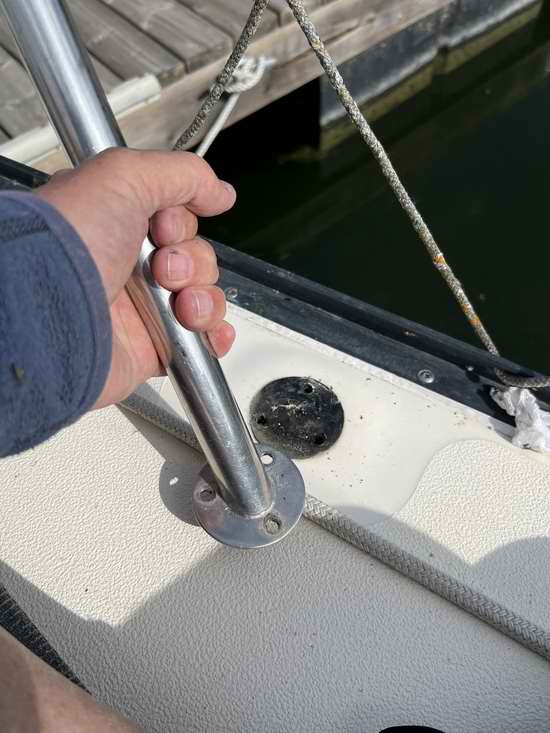
|
Fig 2 - All the sealant was stuck to deck, none to foot. 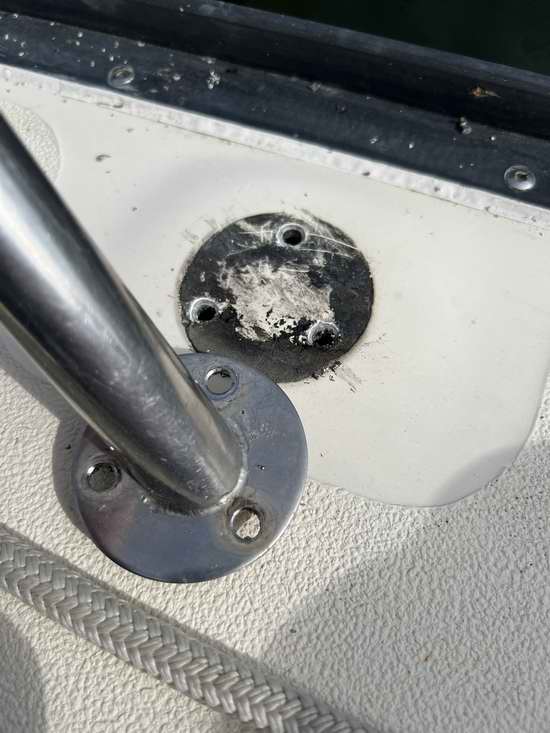
|
| Fig 3 - All clean and sanitized ready for a washer over each hole. 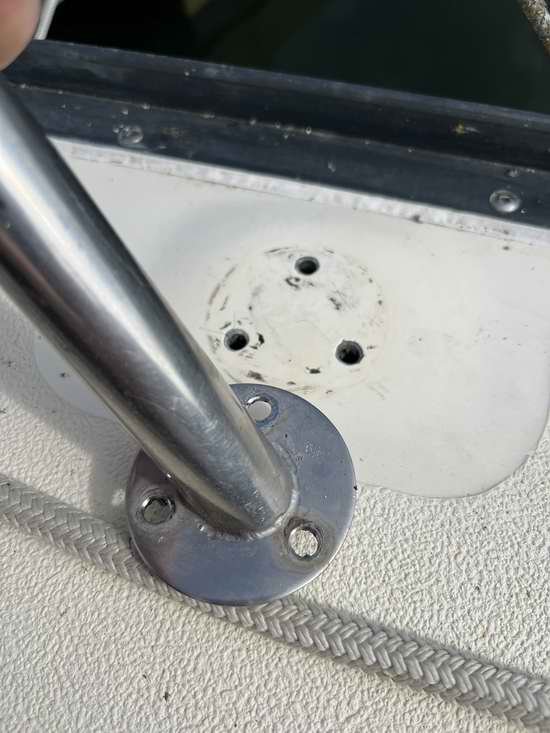
|
Fig 4 - The aligning pin in use to insert mounting bolts. 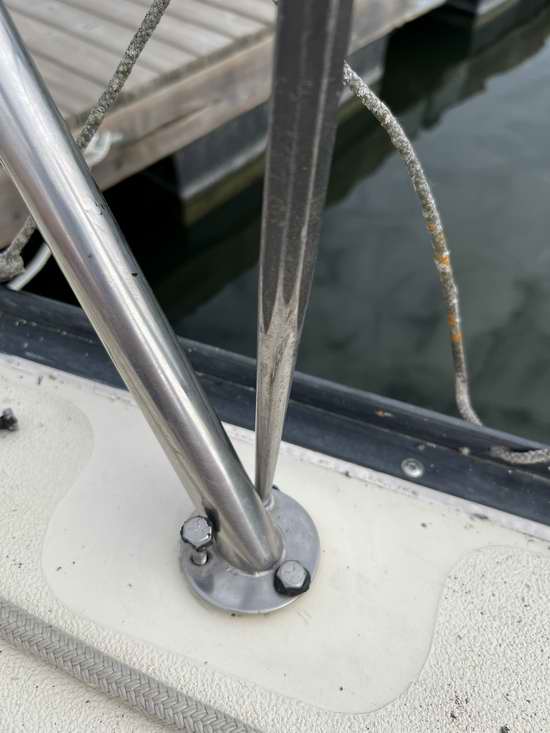
|
| Fig 5 - When you are the only one on the boat you have to improvise. 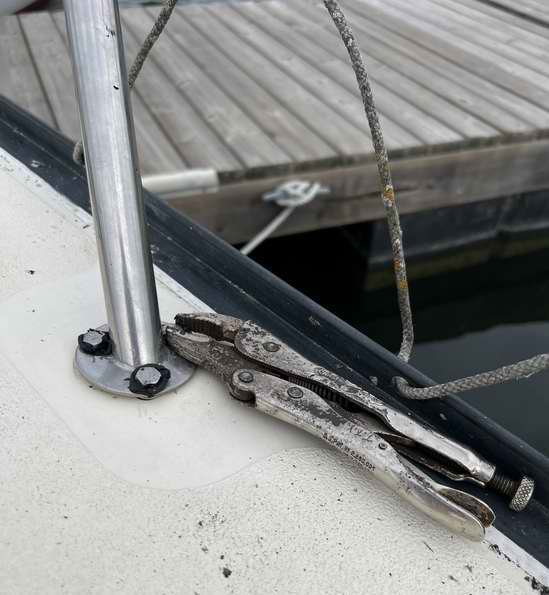
|
Fig 6 - Job done and sealed with ~1/8" thick butyl rubber. 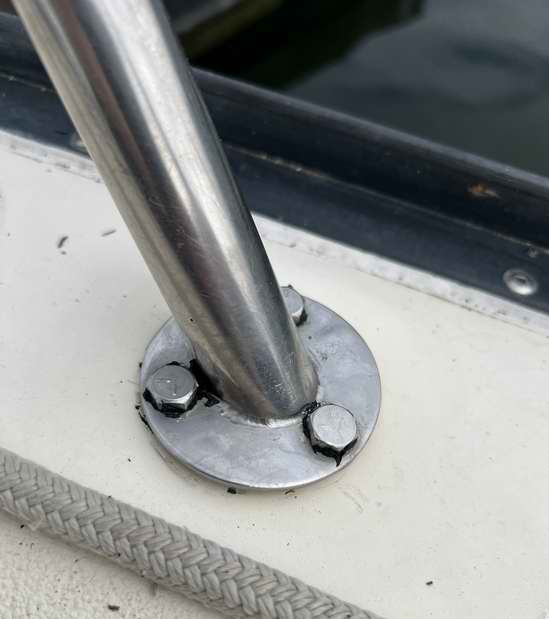
|
MOUNTING BOLTS - The mounting bolts are a unique problem. I have several on
Panache that defy sealing and I'm tired of sponging up the water in the settee bilge. The bottom of a bolt head is seldom a smooth surface and sometimes a bolt goes through the deck at an angle. Neither of these situations is conducive to creating a good seal. To aggravate things, you know that movement can break a seal so your instinct tells you to tighten the "bejesus" out of the nuts. After all, movement causes a deck leak don't you know! Then you come up on deck to discover the sealant was squeezed out from under all the bolt heads you just tightened. This is quickly becoming a bad day.
You could increase the holding power of the bolt head by using a flange bolt that has slightly more surface area under the head, if there is space for the flange. Failing that, I've stuffed sealant around the outside of a bolt head as a desperate solution. It looks ugly but there are times when you just have to do a temporary fix. If it actually keeps water out then somebody is looking after you! You have limited time on a buckshee fix, so time to git to it!
INSTALLATION - Get a buddy to help because you don't have the arms of an orangutan to reach between the deck and the nuts below deck. In any of the following techniques, bevel the hole below the sealant then sanitize the surfaces with acetone before you apply sealant.
- Sealant under Bolt Head - The prescribed technique with a sealant is to sanitize the surface with acetone, apply the sealant in a cone under the bolt head, tighten the bolt to just snug, wait 24 hours for the sealant to cure, tighten to final spec.
- Butyl Rubber under Bolt Head - Sanitize the surface with acetone, roll up a bead of butyl rubber and form it into a cone under the bolt head. The book will instruct you to tighten it to final spec at time of installation. I have had times when a seal failed after several years.
- O-Ring with Butyl Rubber under Bolt Head - I have often wondered how effective an O-Ring under a bolt head would be. Roll it up the 1/4" bolt shaft to under the bolt head. O-rings generally come in 2 sizes; use the thin size so the bolt head doesn't stick up so much. Then pack a cone of butyl rubber under the bolt head, totally covering the O-Ring. Bevel the top of the bolt hole in the foot. This combination should make a good seal that can be snugged up at installation time and retain enough of the butyl rubber. I see no reason why it wouldn't stay sealed over a wide temperature range; from -35C to 30C (the minus one is for storage). After all, this is exactly what I did to reseal Panache's windows that have stayed bone dry since 2005. See Tech Tip B05.
- Gasket under Bolt Head - This technique is really no different than the oodles of gaskets you find in automotive engines that are sometimes backed up with an application of
Permatex Form-a-gasket to seal tiny cracks. A rigid gasket will work if the mating surfaces are machine smooth. A softer gasket will work for a slightly rough surface. But I doubt a gasket will work if the mating surfaces are on different planes (crooked bolt). I haven't pursued this idea any further.
- Specialty Bolt E/W O-Ring under Head - This is a special bolt that has a groove under the head for an O-Ring. You tighten it to final spec at installation time to squeeze and seal the O-Ring. I have not seen these bolts in SS but this gave me an idea for rolling my own O-Ring up the bolt.
|






